Related Research Articles

Linear B is a syllabic script that was used for writing Mycenaean Greek, the earliest attested form of Greek. The script predates the Greek alphabet by several centuries. The oldest Mycenaean writing dates to about 1450 BC. It is descended from the older Linear A, an undeciphered earlier script used for writing the Minoan language, as is the later Cypriot syllabary, which also recorded Greek. Linear B, found mainly in the palace archives at Knossos, Cydonia, Pylos, Thebes and Mycenae, disappeared with the fall of Mycenaean civilization during the Late Bronze Age collapse. The succeeding period, known as the Greek Dark Ages, provides no evidence of the use of writing. It is also the only one of the Bronze Age Aegean scripts to have been deciphered, by English architect and self-taught linguist Michael Ventris.
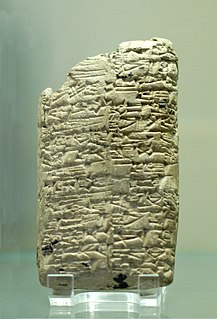
In the Ancient Near East, clay tablets were used as a writing medium, especially for writing in cuneiform, throughout the Bronze Age and well into the Iron Age.

Cuneiform, or Sumero-Akkadian cuneiform, was one of the earliest systems of writing, invented by Sumerians in ancient Mesopotamia. It is distinguished by its wedge-shaped marks on clay tablets, made by means of a blunt reed for a stylus. The name cuneiform itself simply means "wedge-shaped".

The Greco-Turkish War of 1919–1922 was fought between Greece and the Turkish National Movement during the partitioning of the Ottoman Empire after World War I, between May 1919 and October 1922. It is known as the Western Front of the Turkish War of Independence in Turkey and the Asia Minor Campaign or the Asia Minor Catastrophe in Greece.

The Turkish War of Independence was fought between the Turkish National Movement and the proxies of the Allies – namely Greece on the Western Front, Armenia on the Eastern, France on the Southern, the royalists and the separatists in various cities, and with them, the United Kingdom and Italy in Constantinople – after parts of the Ottoman Empire were occupied and partitioned following the Ottomans' defeat in World War I. Few of the occupying British, French, and Italian troops had been deployed or engaged in combat.
Assyriology is the archaeological, historical, and linguistic study of not just Assyria, but the entirety of ancient Mesopotamia and of related cultures that used cuneiform writing. The field covers Sumer, the early Sumero-Akkadian city-states, the Akkadian Empire, Ebla, the Akkadian and Imperial Aramaic speaking states of Assyria, Babylonia and the Sealand Dynasty, the migrant foreign dynasties of southern Mesopotamia, including; the Gutians, Amorites, Kassites, Arameans, Suteans and Chaldeans, and to some degree post-imperial Achaemenid Assyria, Athura, Sassanid Syria, Assyria, and Assuristan, together with later Neo-Assyrian states such as Adiabene, Osroene, Hatra, Beth Nuhadra and Beth Garmai, up until the Arab invasion and Islamic conquest of the mid 7th century AD. Some Assyriologists also write on the further Assyrian continuity of the Assyrian people as well as the Mandaeans into the present day.
Sir Ernest Alfred Thompson Wallis Budge was an English Egyptologist, Orientalist, and philologist who worked for the British Museum and published numerous works on the ancient Near East. He made numerous trips to Egypt and the Sudan on behalf of the British Museum to buy antiquities, and helped it build its collection of cuneiform tablets, manuscripts, and papyri. He published many books on Egyptology, helping to bring the findings to larger audiences. In 1920, he was knighted for his service to Egyptology and the British Museum.
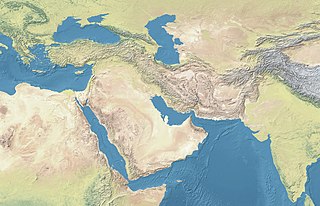
The Proto-Elamite period, also known as Susa III, is the time from ca. 3400 BC to 2500 BC in the area of Elam. In archaeological terms this corresponds to the late Banesh period, and it is recognized as the oldest civilization in Iran.

The Cyrus Cylinder or Cyrus Charter is an ancient clay cylinder, now broken into several pieces, on which is written a declaration in Akkadian cuneiform script in the name of Persia's Achaemenid king Cyrus the Great. It dates from the 6th century BC and was discovered in the ruins of Babylon in Mesopotamia in 1879. It is currently in the possession of the British Museum, which sponsored the expedition that discovered the cylinder. It was created and used as a foundation deposit following the Persian conquest of Babylon in 539 BC, when the Neo-Babylonian Empire was invaded by Cyrus and incorporated into his Persian Empire.

The Nabonidus Chronicle is an ancient Babylonian text, part of a larger series of Babylonian Chronicles inscribed in cuneiform script on clay tablets. It deals primarily with the reign of Nabonidus, the last king of the Neo-Babylonian Empire, covers the conquest of Babylon by the Persian king Cyrus the Great, and ends with the start of the reign of Cyrus's son Cambyses, spanning a period from 556 BC to some time after 539 BC. It provides a rare contemporary account of Cyrus's rise to power and is the main source of information on this period; Amélie Kuhrt describes it as "the most reliable and sober [ancient] account of the fall of Babylon."

Marie Euphrosyne Spartali, later Stillman, was a British Pre-Raphaelite painter of Greek descent, arguably the greatest female artist of that movement. During a sixty-year career, she produced over one hundred and fifty works, contributing regularly to exhibitions in Great Britain and the United States.
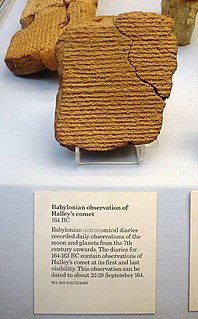
Babylonian astronomy was the study or recording of celestial objects during early history Mesopotamia. These records can be found on Sumerian clay tablets, inscribed in cuneiform, dated approximately to 3500–3200 BC.

Jemdet Nasr is a tell or settlement mound in Babil Governorate (Iraq) that is best known as the eponymous type site for the Jemdet Nasr period, and was one of the oldest Sumerian cities. The site was first excavated in 1926 by Stephen Langdon, who found proto-cuneiform clay tablets in a large mudbrick building thought to be the ancient administrative centre of the site. A second season took place in 1928, but this season was very poorly recorded. Subsequent excavations in the 1980s under British archaeologist Roger Matthews were, among other things, undertaken to relocate the building excavated by Langdon. These excavations have shown that the site was also occupied during the Ubaid, Uruk and Early Dynastic I periods.
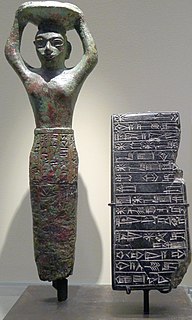
Amar-Sin, initially misread as Bur-Sin was the third ruler of the Ur III Dynasty. He succeeded his father Shulgi. His name translates to 'immortal moon-god'.
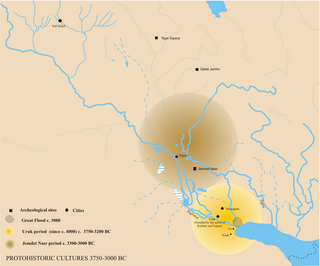
The Jemdet Nasr Period is an archaeological culture in southern Mesopotamia. It is generally dated from 3100–2900 BC. It is named after the type site Tell Jemdet Nasr, where the assemblage typical for this period was first recognized. Its geographical distribution is limited to south-central Iraq. The culture of the proto-historical Jemdet Nasr period is a local development out of the preceding Uruk period and continues into the Early Dynastic I period.
Niqmepa, son of Idrimi, was King of Alalakh in the first half of 15th century BC.

The Tablet of Shamash is a stone tablet recovered from the ancient Babylonian city of Sippar in southern Iraq in 1881; it is now a major piece in the British Museum's ancient Middle East collection. It is dated to the reign of King Nabu-apla-iddina ca. 888 – 855 BC.
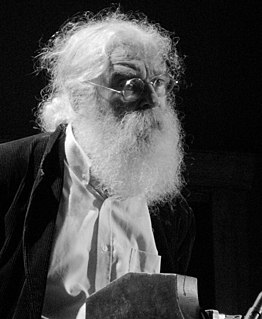
Irving Leonard Finkel is a British philologist and Assyriologist. He is currently the Assistant Keeper of Ancient Mesopotamian script, languages and cultures in the Department of the Middle East in the British Museum, where he specialises in cuneiform inscriptions on tablets of clay from ancient Mesopotamia.
Stephanie Mary Dalley FSA is a British scholar of the Ancient Near East. She has retired as a teaching Fellow from the Oriental Institute, Oxford. She is known for her publications of cuneiform texts and her investigation into the Hanging Gardens of Babylon, and her proposal that it was situated in Nineveh, and constructed during Sennacherib's rule.

The Oriental Carpet Manufacturers (OCM) was a London-based company involved in the production of, and trade with, Oriental carpets. Established in 1907/8 in Istanbul, the company set up and controlled their own carpet manufactures in the central Anatolian region around the town of Konya, and from 1911 onwards, in the Hamadan Province in northwestern Iran. In 1968 it was sold, and merged with one of its former affiliates, the Eastern Kayyam Company. From 1924 until 1948, OCM was led by Arthur Cecil Edwards, who, after retiring, wrote a text book on Persian Carpets, which is still in print today.
References
- ↑ Commercial relations of the United States with foreign countries, Volume 1. Bureau of Foreign and Domestic Commerce, United States. 1903. p. 1145.
- ↑ Chapman, Stanley (2004). Merchant Enterprise in Britain: From the Industrial Revolution to World War I. Cambridge University Press. p. 157. ISBN 978-0-521-89362-6.
- ↑ The Manchester commercial list. Seyd and co. 1867. p. 19.
- ↑ Christian, John; Stevens, Mary Ann (1989). The Last romantics: the romantic tradition in British art, Burne-Jones to Stanley Spencer. Lund Humphries in association with Barbican Art Gallery. ISBN 978-0-85331-552-0.
- ↑ "Official website: Carpet/rug cleaning" . Retrieved 7 September 2017.
- ↑ Chapman, T.C.; Searight, Ann (2007). Catalogue of the Western Asiatic seals in the British Museum: impressions of stamp seals on cuneiform tablets, clay bullae, and jar handles, volume 3. Brill. p. 18. ISBN 978-90-04-15615-9.
- 1 2 "Spartali & Co". British Museum. Retrieved 2009-11-28.
- ↑ Quataert, Donald (2002). Ottoman Manufacturing in the Age of the Industrial Revolution. Cambridge University Press. p. 151. ISBN 978-0-521-89301-5.